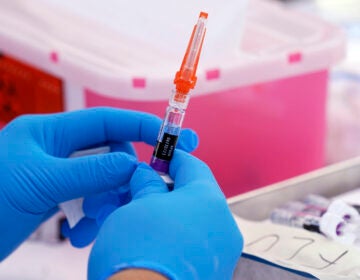What’s ailing long COVID patients? A new federal study looks for clues

Nancy Rose (right), who contracted COVID-19 in 2021 and continues to exhibit long-haul symptoms, including brain fog and memory difficulties, cooks for her mother, Amy Russell, at their home, Tuesday, Jan. 25, 2022, in Port Jefferson, N.Y.
Soon after the COVID-19 pandemic began, a team of researchers at the National Institutes of Health started putting hundreds of people under the microscope to try to get clues to why some patients might end up with long-lasting health problems.
The scientists knew from previous outbreaks of infections diseases, like Ebola, that some patients would likely be left struggling with symptoms that could be debilitating.
Doctors combed through the volunteers’ medical records looking for anything that might predispose them to the lingering health problems that later would be called long COVID, symptoms like fatigue, headaches, and shortness of breath. The researchers also put the subjects through more than 130 tests for any signs their vital organs were damaged, that the virus was still hiding in their bodies, or their immune systems were malfunctioning.
On Tuesday, the scientists released the first results from the study, which is ongoing. The study, published in the Annals of Internal Medicine, compared 189 patients diagnosed with COVID-19 to 120 similar patients who did not get sick.
The results are both disappointing and provocative.
“An extensive medical evaluation failed to reveal a cause for these persistent symptoms in most cases,” Dr. Michael Sneller, an infectious disease specialist, who led the study, told NPR.
“We were not able to find evidence of the virus persisting or hiding out in the body. We also did not find evidence that the immune system was overactive or malfunctioning in a way that would produce injury to major organs in the body,” Sneller says.
The researchers did, however, find that women and those suffering from anxiety were more likely to end up with long COVID. But the researchers stress that their findings don’t mean patients’ problems are psychological.
“I clearly don’t want to send the message that this is all not real. And in peoples’ heads. And just go home and stop worrying about it. That’s not the message,” Sneller says.
Sneller says he hopes his findings will help doctors better treat long COVID patients. For example, by identifying what’s not wrong, doctors could avoid avoid unnecessary, potentially harmful treatments. Some doctors are prescribing inhalers which can cause side effects, to people with normal lung function, he says.
Instead, Sneller says his research could prompt more doctors to focus on interventions that might help, such as physical and cognitive behavioral therapy.
But some worry the findings could send the wrong message. The fear is doctors will dismiss patients, especially when nothing shows up on standard tests.
“We know that invisible illnesses are often psychologized,” says David Putrino, a professor of rehabilitative medicine, who studies and treats long COVID patients at Mount Sinai Medicine in New York.
“We know that most people with infection-associated chronic illness are constantly first misdiagnosed with anxiety. Regular cookie-cutter testing isn’t going to show up anything in your long-COVID patients. We need to look deeper,” Putrino said.
For example, Putrino says other researchers have found evidence of abnormal levels of immune system modulators in patients suffering from long-COVID. Others have found evidence of chronic inflammation, which is a sign of an overactive immune system.
In an editorial accompanying the study, Dr. Aluko Hope of the Oregon Health & Science University calls the results a “valuable contribution” to understanding long COVID by providing a baseline of patients’ health early on in their disease.
But he notes the researchers didn’t focus enough on understanding the fatigue many long-COVID patients experience when they try to exercise or otherwise exert themselves.
“As we emerge from the hell of the COVID-19 pandemic, it is time to insist on painstaking study and care of survivors of COVID-19. Without a fuller understanding of pathophysiology and disease course, we must not allow normal objective tests to negate our patients’ subjective experiences,” Hope says.
“While we gather evidence, our patients deserve personalized care pathways that acknowledge the many biopsychosocial factors involved in illness recovery,” he says.
Sneller agrees. He’s continuing to study the first patients in his study as well as hundreds of others, including conducting additional tests.
“We continuing the analysis looking for any evidence of autoimmunity or anything else,” Sneller says. “This paper is not the end of it — it’s just the beginning.”
At the same time, a new NIH study aims to follow about 20,000 COVID-19 patients, conducting detailed analysis of their health and comparing them to people who don’t get COVID.
In the end, many experts think research will show that long COVID likely has many different causes, depending on such factors as the severity of the initial illness and an individual’s predisposing characteristics.
9(MDAzMzI1ODY3MDEyMzkzOTE3NjIxNDg3MQ001))


![CoronavirusPandemic_1024x512[1]](https://whyy.org/wp-content/uploads/2020/03/CoronavirusPandemic_1024x5121-300x150.jpg)


